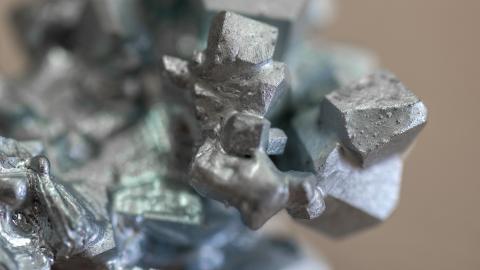Introduction
President Donald Trump’s Section 232 automotive tariffs of 25 percent have dominated media discussion. But another aspect of President Trump’s trade program may have an even greater impact: it showcases in stark relief the critical minerals shortage made possible by the People’s Republic of China’s supply chain dominance. Absent a significant shift in China’s political economy and industrial policy, which is the source of friction between Washington and Beijing, American auto consumers will not be searching for the best deal—they will be wondering whether they will have cars to buy at all.
This may sound like hyperbole. But in early June, automotive industry officials warned that their firms’ stockpiles of certain critical components—those that require rare earth minerals—would last a matter of days. For years government officials and policy experts have warned that China could use its processing dominance of critical minerals as a tool of economic coercion against the United States and other Western economies. For American allies such as Japan, these threats have already become reality. China cut off mineral exports to Japan in 2010 after their dispute over the Senkaku Islands.
Yet as governments negotiate with Beijing to secure sufficient supplies of rare earth materials to support their industries, it is important to realize that these shortages transcend tariffs or export controls. These mineral shortages and export license backlogs are part of Beijing’s strategic effort to accelerate technology transfer and advance Chinese control over entire supply chains through bureaucratic means. To overcome China’s economic coercion, the US and its allies will need to develop alternative sources of production and processing of critical minerals and shield them from Chinese price manipulation.
Critical Minerals, Rare Earths, and Chinese Restrictions
China wields near-total control over critical minerals, a subset of materials that includes rare earth elements. Critical minerals and materials are broad categories whose definitions differ by country and even by agency, as demonstrated by the overlapping but separate lists maintained by the US Geological Survey, Department of Energy, and Defense Logistics Agency. Regardless of the precise definition, the category of critical minerals encompasses a broad range of raw materials that are crucial to the production of high-end, high-tech goods vital for commercial and defense applications, ranging from vehicles to F-35 fighter aircraft.
Rare earth elements are divided into “light” and “heavy” classes. Light rare earths consist of minerals such as lanthanum, neodymium, and samarium. Heavy rare earths include dysprosium, terbium, holmium, erbium, thulium, ytterbium, yttrium, and lutetium. China controls 58 percent of global production of light rare earths and 90 percent of heavy rare earths. The remaining 10 percent of heavy rare earths are produced in Myanmar, a pariah state that is closely aligned with China. Even more importantly, China oversees 90 percent of rare earth processing from ores and accounts for more than 80 percent of the market for rare earth magnets.
Deng Xiaoping once said, “The Middle East has oil; China has rare earths.” Consequently, China has long used its control over critical minerals and rare earths as a geopolitical weapon. In September 2010, China cut off rare earth element exports to Japan after a Chinese fishing trawler collided with Japan Coast Guard vessels off the disputed Senkaku Islands in the East China Sea. In August 2023, in response to increased American restrictions on chip exports to China, China’s Ministry of Commerce (MOC) announced strict export controls on germanium and gallium, which are crucial to making semiconductors and fiber-optics. In December 2024, Beijing announced an export ban on those two minerals. From 2022 to 2024, Chinese global exports of gallium fell by 36 percent, and germanium fell by 42 percent, with the US and close industrial partners such as Japan and the Netherlands suffering most from the cuts.
China’s latest salvo in this mineral coercion campaign occurred on April 4, when Beijing responded to the Trump administration’s April 2 reciprocal tariffs with export restrictions on seven rare earths: samarium, gadolinium, terbium, dysprosium, lutetium, scandium, and yttrium.
These restrictions concerned the automotive industry. In a letter to the White House, the Alliance for Automotive Innovation, the leading trade group for all carmakers operating in the US, warned that the lack of access to these minerals and magnets would prevent production of key automotive components such as automatic transmissions, certain motors and sensors, seat belts, speakers, power steering, and cameras. Automakers in Japan, India, Europe, the US, and beyond experienced manufacturing disruptions and warned of even greater calamities. Some industry sources reported that supplies would run out in a matter of a few weeks, if not days. In May, Ford Motor Company shut down its Chicago plant for a week because of a shortage of components that used rare earth minerals. The shortage was so dire that some automakers and suppliers were considering producing electric motors in Chinese plants or shipping American-made engines to have rare earth magnets installed in China.
Expanding American automotive manufacturers’ reliance on China would be a propaganda coup for Beijing. The Trump administration’s reciprocal tariffs against the PRC and Section 232 tariffs on automobiles were designed to incentivize firms to shift production back to the US. China seeks to use its critical minerals stranglehold to force automakers to do the opposite. For Beijing, winning this battle of economic coercion would also be a propaganda victory over the United States.
In the short term, there is no prospect that such adversarial dynamics will change. Negotiations in Geneva in May and London in June resulted in a truce on trade and relaxed Chinese rare earth restrictions. But Beijing slowly took action to reestablish pressure on US rare earths supplies. Continued tensions over semiconductor export controls, fentanyl, and Chinese citizens’ access to US higher education give the PRC ample excuses to restart or even expand its mineral export restrictions.
The US has tried to lessen its dependency on PRC rare earth magnets in the past. But prior efforts have merely pushed the problem up the supply chain. The 2019 National Defense Authorization Act prevented the US military from using samarium and neodymium rare earth magnets from China. Unfortunately, given Chinese domination of the rare earth magnet industry, this forced the Pentagon to rely on Japanese and other Western magnet manufacturers who occupied a shrinking share of the market. Even more worryingly, the curbs will eventually include any magnet that contains materials mined or processed in China—a category that encompasses almost the entirety of the world’s supply.
China’s Bureaucracy: Technology Transfer and Manufacturing Dominance
Bureaucratic procedure is central to Beijing’s rare earths economic coercion campaign. It leverages this in three ways: (1) throttling adversaries’ access to critical minerals, (2) forcibly acquiring foreign technology, and (3) overtaking and dominating manufacturing supply chains related to rare earths.
Throttling Supply
Chinese political power has been defined by its bureaucratic tradition for nearly 1,500 years. So it is no surprise that MOC procedures play a key role in obscuring and justifying Beijing’s rare earth export restrictions. China-based foreign firms seeking to export rare earth materials out of China must navigate a time-consuming, circuitous application process. According to industry and government officials, an applicant seeking to export rare earth magnets may need to prepare hundreds of pages of documents and send them to the local MOC office just to receive an export control number. Only after waiting and receiving this number can the applicant then send the export license materials to the central MOC office in Beijing for review. This should technically last up to 45 days. But the MOC can extend the process multiple times with requests for further information and documentation. Many firms undergo this arduous process only to have their application rejected.
For the automotive industry, which operates on just-in-time principles that minimize inventory and delays, the lengthy and arbitrary nature of the MOC’s export license application process creates significant supply chain disruptions. The MOC has two goals in this process. First, it seeks to inflict as much pain as possible on foreign automakers to hurt their business prospects. Second, the MOC wants to stop foreign firms from moving operations out of China as they de-risk their supply chains, and instead force them to rely on the PRC more by showing them the consequences of de-risking.
Forcing Technology Transfer
China also uses rare earths bureaucracy to coerce firms into technology transfers. Several automakers and parts suppliers, such as Bosch, have reported that MOC export license applications demand extraordinarily detailed and invasive information. China’s information demands stretch far beyond normal requests. They include:
- Blueprints of the component in which rare earth materials will be used
- Information on the function of the earth material within the component
- Images of where the rare earth materials will be used within the component
- Information on the function of the component within the final product
- Images of where the component will be placed within the final product
- Data and projections on annual production volumes of the component for the past three years and the next three years
- Company names, product names, and manufacturing processes used across the entire supply chain, complete with pictures of production lines
- Images of the final assembled product that contains rare earth materials
- The destination country or region of the final product
- Photos of the manufacturing sites of each supplier or manufacturer in the entire value chain
These invasive questions are far beyond what would be required to screen for illicit use of materials. Beijing’s bureaucrats are instead acquiring technical and business intelligence the government can and will give to Chinese manufacturers so that they will have significant competitive advantages—a process that constitutes outright technology theft.
Dominating Supply Chains
In addition to these efforts to weaken foreign automotive competition, China is using its control over critical minerals to achieve manufacturing dominance over entire supply chains in other industries. For example, China oversees 99 percent of global production of gallium, which is subject to Beijing’s 2023 export control measures. Gallium is needed in neodymium magnets and in compounds such as gallium arsenide, gallium nitride, and gallium oxide. These compounds are used in motor actuators, light-emitting diodes (LEDs), laser diodes, power semiconductors, and high-frequency devices, which in turn are incorporated into final products such as automobiles, smartphones, LiDAR (light detection and ranging) devices, radar, and mobile phone base stations. Simply put, Gallium is a crucial material to the American economy and US national security.
China has already demonstrated the damage it can inflict by leveraging global dependencies on its gallium. After the 2023 export restrictions, China ceased gallium exports for six to nine months, driving gallium prices up 60 percent to $38,000 per ton in November 2023. This created severe complications for manufacturing and led companies to stockpile in case of future Chinese cutoffs. Though the United States reduced its dependency on Chinese gallium by increasing its imports from Japan, the benefits were a mirage. The bulk of America’s consumption of gallium—83 percent—comes in the form of compounds, of which Japan and Germany are the leading producers. Shifting American sourcing and applications for export licenses of Chinese gallium to Japan and Germany merely passed the buck from the United States, putting pressure on corporate as well as Japanese and German national reserves.
Japanese industry and governmental officials allege that China seeks to use gallium export controls to eventually control the entire supply chain. Japan currently enjoys a significant share of the production of gallium-derived compounds. But China has reduced its gallium exports to Japan by 80–90 percent since 2023. China’s approach, according to some Japanese officials, is intended to reduce Japan’s share of gallium compound production, possibly in favor of Germany, through speedier export licenses. Some German industry officials acknowledged this possibility. The Japanese argue that this benefit for German producers will only be temporary and that Beijing will similarly turn against Berlin once China dominates global production of gallium compounds. Afterwards, the PRC will repeat the process for the components in which these gallium compounds are used. Beijing’s endgame is for Chinese producers to control the entire supply chain and to possess a significant share of final goods. Foreign assemblers will be in the unenviable position of facing stiff Chinese competition while remaining utterly dependent on Chinese components.
Policy Recommendations
The past 15 years show that China’s dubiously justified use of minerals for economic coercion, technology transfer, and manufacturing dominance will not cease until the United States and its allies resolve their dependencies. To do so they will need to resolve two challenges: (1) increase the supply of non-Chinese critical minerals and (2) neutralize China’s predatory use of price advantages, which undermines alternative mineral supply chains.
The Trump administration has signaled its resolve to address the supply issue. The March 20 executive order Immediate Measures to Increase American Mineral Production announced the administration’s ambitions to increase both the production and processing of critical minerals in the United States. The executive order asks federal agencies to streamline the permitting processes for infrastructure and energy projects that are vital to American security and economic prosperity. Combined with the White House’s executive orders to increase energy production and to facilitate and accelerate domestic and foreign investment, the administration is creating the basis for increasing the supply of non-Chinese critical minerals.
The program has already produced a number of positive results. In the past few months, the Trump administration has designated several critical mineral programs for FAST-41 status, which enables them to receive comprehensive permitting timetables and dedicated project plan management from the Permitting Council (formerly known as the Federal Permitting Improvement Steering Council). Though the Mountain Pass mine in California, managed by the firm MP Materials, remains the only active rare earths mine in the United States, there have been new projects announced this year. Australian mining firm Lynas received $258 million from the Department of Defense to build a heavy rare earths refinement facility in Texas. NioCorp, an American mining firm, has the permits to build a rare earths processing facility in Nebraska, and is awaiting $780 million in financing from the US Export-Import Bank for this $1.2 billion project.
Allied cooperation is also necessary for creating new non-Chinese sources of critical minerals. Lynas’s investment in Texas is significant. Tokyo turned to Lynas in the 2010s as part of its effort to reduce Japanese reliance on Chinese rare earths after the Senkaku Islands incident. At the July 2025 meeting of the Quad (which includes the United States, Japan, Australia, and India), all members agreed to launch the Quad Critical Minerals Initiative. This initiative will promote public-private partnerships to help diversify critical mineral supply chains. Other foreign cooperative efforts for critical minerals include: (1) American firm MP Materials’ memorandum of understanding with Saudi Arabia’s national mining company, Maaden, to collaborate on establishing a rare earths supply chain in Saudi Arabia and (2) Tokyo’s agreement with Japanese gas firm Iwatani to invest $120 million in a French rare earths project. This latter deal was organized through the Japan Organization for Metals and Energy Security (JOGMEC), which also spearheaded the cooperation with Lynas in the 2010s.
Though these projects are in the early stages, allied cooperation on critical minerals and rare earths is essential to secure steady supplies of these materials. China will inevitably attempt to drive wedges between partners. Beijing’s decision to favor critical mineral exports to Germany over Japan is an example of this. The European Union in particular needs to understand Beijing’s intentions and maintain clear-eyed resolve to resist Chinese efforts to water down EU economic security and trade measures. Brussels’s recent retreat from its punitive tariffs against Chinese automakers in favor of minimum prices for Chinese cars is a step in the wrong direction.
Beyond creating new sources of critical minerals, US and allied firms need creative solutions to remain economically viable. Currently, China’s critical mineral advantage allows it to manipulate prices to put competitors out of business. To stabilize prices, James Litinsky, chief executive officer of MP Materials, has suggested that the US government form public-private partnership insurance corporations. Taking inspiration from the Federal Crop Insurance Corporation created in 1938, he recommends a similar framework for critical minerals to provide revenue protection for key segments of the supply chain, such as mining, refining, and magnet production. Providing price assurances to both mineral producers and users would create the necessary conditions to encourage stable production and long-term purchase contracts to shield against Chinese price manipulation.
Better enforcement of international labor and environmental standards would also help US and allied firms compete with Chinese firms’ prices. Beijing has reduced the high labor and energy costs of rare earths mining by increasing energy production (China reached a 10-year high in coal power construction in 2024) and using forced Uyghur labor to mine rare earths in Xinjiang. This combination of cheap labor and abundant energy makes it impossible for foreign firms to compete while maintaining ethical and environmental standards.
The US government has already placed China’s use of forced labor and dirty energy under the microscope. In December 2021, Congress passed the Uyghur Forced Labor Prevention Act (UFLPA), which targets companies that import goods from Xinjiang into the US that were made with forced labor. Several Chinese mining firms have already been added to the entity list. As the US and its allies begin developing their own critical mineral and rare earths production and refining sources, they should mandate that manufactured goods use materials produced with trusted and verifiable labor standards. Such a measure would help push back against Chinese price advantages.
To combat China’s use of lower environmental and energy efficiency standards, there is increasing interest in the United States in a “carbon tariff.” First proposed by Senators Bill Cassidy (R-LA) and Lindsey Graham (R-SC) in 2023 and renewed in 2025, the Foreign Pollution Fee Act would levy tiered and escalating tariffs against select foreign imports to offset their price competitiveness due to lower environmental standards. The concept has received bipartisan support, including from Senators Sheldon Whitehouse (D-RI) and Angus King (I-ME). Most importantly, Secretary of the Treasury Scott Bessent and US Trade Representative Jamieson Greer appeared interested in the bill during their respective Senate confirmation hearings. Combined with stringent anti–forced labor standards, a carbon tariff regime may advance Greer’s desire to address unfair Chinese trading practices in all areas, not just critical minerals.
Conclusion
As of the June negotiations in London, the immediate danger of China fully exploiting its dominance over rare earths has receded. On June 27, the Trump administration announced that it had reached an additional understanding for a framework to implement the original Geneva agreement made in May. China would expedite its shipments of rare earths to the United States, and in exchange Washington would reduce tariff rates to 55 percent and ease curbs on Chinese students studying in America. Automakers confirm the shift, noting that the approval rate of MOC rare earth licenses had increased from 25 percent to 60 percent—though approvals for American end-users are still taking longer and are a lower priority for Beijing. Industry experts believe that production of components containing rare earths should be stable through July, a far cry from earlier in June when viable production periods were said to number in days.
Still, China’s willingness to use bureaucratic procedure to (1) capitalize on and expand its dominance of rare earth mineral production and processing, (2) acquire foreign technical and competitive business information, and (3) expand its control over entire supply chains is a clear warning. Though Presidents Donald Trump and Xi Jinping achieved a temporary reprieve, Beijing’s political priorities, technological ambitions, and weak economic fundamentals ensure that friction between China and the United States will not end any time soon. Washington and its allies need to cooperate and coordinate their efforts to expand the supply of critical minerals and to create frameworks that make them economically viable against Chinese price manipulation. Doing so quickly and effectively is the only way to overcome Beijing’s persistent capacity to blackmail the US and its allies with its critical mineral dominance.














